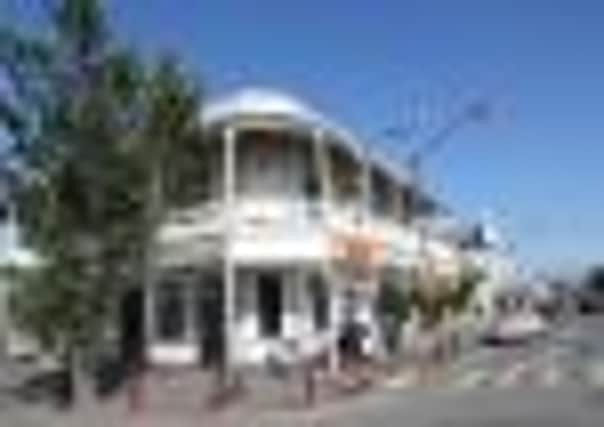Noir thriller down under


The name of the town comes from John Martin, a 19th century Irish immigrant who bought a large sheep station in the region and decided to set up his own town. Bizarrely he laid out the centre of town in the form of a Union Jack and named the streets after some of the places he had visited on his travels.
Now streets such as Venice, Suez, Panama and New York lend a cosmopolitan air which suits the thriving hub of cafés, bars and small shops that Martinborough has become. My hotel, built in the late 1800s is a gently-restored reminder of the old days with its grand balconies and colonial style.
Advertisement
Hide AdAdvertisement
Hide AdBut John Martin never thought about growing grapes. It was a government report which suggested that the region was suitable for vines and over the last 30 years the number of vineyards has steadily increased, most of them clustered together on a two-mile stretch of stony river terrace which provides mineral-rich, free-draining soils. The climate is key. Tucked behind a range of hills, separating it from the blustery capital city, Wellington, this is a sheltered place, with low rainfall and long dry autumns that allow the grapes to ripen slowly.
Yesterday I caught up with some of the growers of the region, in particular Larry McKenna of Escarpment who is a frequent visitor to Yorkshire. Although he also makes some rather good Riesling and Pinot Gris as well as an excellent Chardonnay, it is Pinot Noir which really puts his wines into the world-class category. One part of his vineyard doesn’t look like New Zealand at all. The vines are close-planted with 7,000 vines per hectare, almost twice the density of many other vineyards, and they are low to the ground.
“This means that each vine carries only half as much fruit compared with the usual wide spacing, and so there is more concentration in the grapes,” said Larry. It also means that the vineyard crew has to get down low to look after the vines, so special wheelie trolleys were invented so they could scoot along the rows.
While I was there the crew was plucking the leaves from around the still-green bunches of grapes to expose them to the sunshine while keeping plenty of leaves above the fruiting zone to act as a powerhouse for the vine.
Advertisement
Hide AdAdvertisement
Hide Ad“By doing this we can achieve ripeness a little earlier and so keep alcohol levels under control,” said Larry. Top-notch winemaking includes some whole bunch fermentation, gently plunging the cap of skins under the fermenting juice using long-handled plungers and a period of oak ageing.
The first level Escarpment Pinot Noir 2010 (around £19.99) is made from a blend of all the blocks on the property and has great open-hearted black cherry fruit, a good structure and layers of complexity developing on the finish.
Kupe 2010 (around £28.99) comes from the low, close-planted vineyard and is a fabulous expression of fruit, complexity and silky tannins with a definite French accent. There are individual vineyard wines, Pahi, Kiwa and Te Rehua, each with their own style and nuances of flavour within the Escarpment family.
Harrogate Fine Wine and The Halifax Wine Company stock a good range of Escarpment wines and while the 2010 vintages may not yet have arrived, older vintages will have had time to develop.
Advertisement
Hide AdAdvertisement
Hide AdWhile Martinborough is a great place to grow vines, it is part of a wider region called Wairarapa, incorporating two other areas, Gladstone and Masterton.
I visited Gladstone Vineyard where the soil is so bony that they grow a mix of buckwheat, chicory and lucerne to build up enough biomass to support the vines. Winemaker Gerhard Smith uses a mix of organic and biodynamic methods to get the most from his crop and it shows in the quality of his ripe, tropical fruit style Sauvignon Blanc 2010 and the nutty, expressive oaked Sauvignon Sophie’s Choice 2010. The Pinots were good, in particular the 2010 which mixes savoury fruit with weight and power. So far Gladstone wines are difficult to find in our area but the owners were already on a UK selling mission while I was at the property.
On any trip to a region, especially a whistle-stop trip like this it is impossible to visit all the producers I would like to, so a big regional tasting was put on for me. These are the best of the wines I tasted.
Ata Rangi Crimson 2010 – A vibrant, lively style of Pinot Noir that combines juicy red fruits with touches of spice and silky, light tannins. Find this at Harrogate Fine Wine (£17.99).
Advertisement
Hide AdAdvertisement
Hide AdMartinborough Te Tera Pinot Noir 2011 – Martinborough was one of the first producers to make an impact with their Pinots while Larry McKenna was winemaking there. Now with Paul Mason at the helm, these wines combine ripe cherry fruit with layers of chocolate and herbal savoury notes. Te Tera is currently stocked at Majestic (£15.99) although they have run out right now.
Te Hera – a small producer who hardly makes enough to export but I loved these wines.
Brodie Estate Pinot Noir 2008 – Another hard-to-find estate, making dense, powerful wines. Well worth an independent merchant following up.
Burnt Spur Pinot Noir 2010 – elegant in style with silky cherry fruit and a long balanced finish.
Find it at www.winedirect.co.uk at around £15.